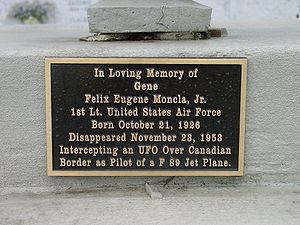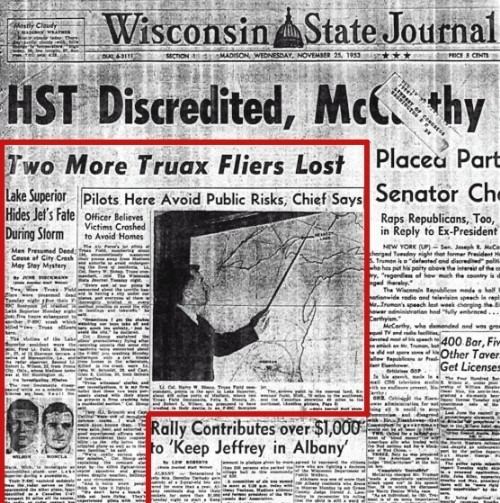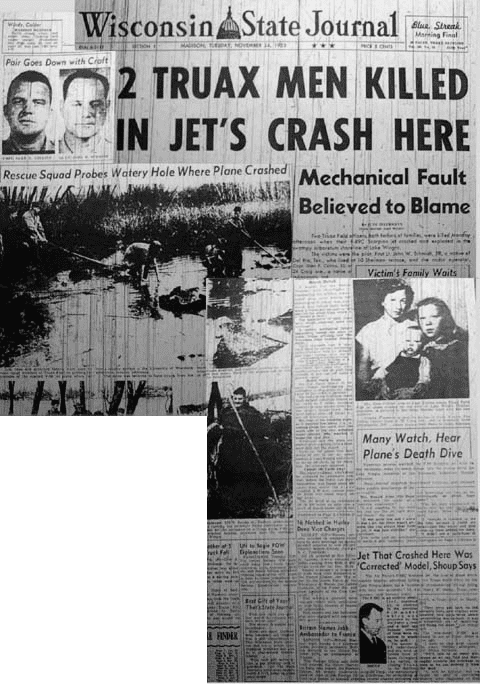Nickname(s) Gene Role Pilot | Name Felix Moncla Rank First Lieutenant | |
 | ||
Born October 21, 1926Mansura, Louisiana ( 1926-10-21 ) Years of service 1945-1946 U.S. Army1950-1953 U.S. Air Force Service/branch | ||
Allegiance United States of America | ||
Felix Moncla - The Scary, Strange, and Outright Odd Show
O caso Felix Moncla
First Lieutenant Felix Eugene Moncla, Jr. (October 21, 1926 – presumably died November 23, 1953) was a United States Air Force pilot who mysteriously disappeared while performing an air defense intercept over Lake Superior in 1953. This is sometimes known as The Kinross Incident, after Kinross Air Force Base, where Moncla was on temporary assignment when he disappeared.
Contents
- Felix Moncla The Scary Strange and Outright Odd Show
- O caso Felix Moncla
- Biography
- Jet scrambled to investigate a radar blip
- Two blips appear to merge then both vanish
- USAF Accident Investigation Report
- Contradictions in official USAF explanations
- Reports of parts found in 1968
- 2006 Great Lakes Dive Company hoax
- References

The U.S. Air Force reported that Moncla had crashed and that the object of the intercept was a Royal Canadian Air Force aircraft. According to the report, the pilot of the Canadian aircraft was later contacted and stated that he did not see the intercepting plane and did not know that he was the subject of an interception.

On multiple occasions, the RCAF denied that any of their aircraft was "involved in any incident" on that day, in correspondence with members of the public asking for further details of the intercept.

Biography

Moncla was born in Mansura, Louisiana on October 21, 1926 to Felix, Sr. (1894–1957), a high school science teacher, principal, and veteran of World War I, and Yvonne Beridon Moncla (1900–1961), a seamstress. He also had two older sisters, Leonie and Muriel Ann. Not long after his father had been hospitalized, the family moved to Moreauville, Louisiana to live with his uncle and great aunt. He attended high school in the area and after graduating accepted an athletic scholarship to Southwest Louisiana Institute (now University of Louisiana at Lafayette) where he played football and received his Bachelor of Science degree. After graduation, he enlisted in the U.S. Army and served during World War II in occupied Japan. After his service, he attended the University of New Orleans, but reenlisted in the military at the start of the Korean War in 1950 in the United States Air Force as an officer pilot trainee.

After spending a few months at a desk job in Dallas, Texas, Moncla was sent to Connally Air Force Base in Waco, Texas for basic pilot training where he met and married Bobbie Jean Coleman. He took his advanced pilot training at Reese Air Force Base in Lubbock, Texas and further training on the F-89 Scorpion at Tyndall Air Force Base in Panama City, Florida. In Panama City, Bobbie Jean gave birth to their first son. In July, 1952, Moncla and his family moved to Madison, Wisconsin and had a daughter born five months before Felix Moncla's disappearance.
Jet scrambled to investigate a radar blip

On the evening of November 23, 1953, Air Defense Command Ground Intercept radar operators at Sault Ste. Marie, Michigan identified an unusual target near the Soo Locks. An F-89C Scorpion jet from Kinross Air Force Base was scrambled to investigate the radar return; the Scorpion was piloted by First Lieutenant Moncla with Second Lieutenant Robert L. Wilson acting as the Scorpion's radar operator.

Wilson had a difficult time tracking the object on the Scorpion's radar, so ground radar operators gave Moncla directions towards the object as he flew. Moncla eventually closed in on the object at about 8000 feet in altitude.
Two blips appear to merge, then both vanish

Ground Control tracked the Scorpion and the unidentified object as two "blips" on the radar screen. The two blips on the radar screen grew closer and closer, until they seemed to merge as one (return). Assuming that Moncla had flown either under or over the target, Ground Control anticipated that moments later, the Scorpion and the object would again appear as two separate blips. Donald Keyhoe reported that there was a fear that the two objects had struck one another "as if in a smashing collision."
Rather, the single return continued on its previous course.
Attempts were made to contact Moncla via radio, but this was unsuccessful. A search and rescue operation by both the USAF and the RCAF was quickly mounted, but failed to find a trace of the plane or the pilots. Weather conditions were a factor in hampering the search.
USAF Accident Investigation Report
The official USAF Accident Investigation Report states the F-89 was sent to investigate an RCAF C-47 Skytrain which was travelling off course.
The F-89 was flying at an elevation of 8000 feet when it merged with the other aircraft, as was expected in an interception. Its IFF signal also disappeared after the two returns merged on the radar scope. Although efforts to contact the crew on radio were unsuccessful, the pilot of another F-89 sent on the search stated in testimony to the accident board that he believed that he had heard a brief radio transmission from the pilot about forty minutes after the plane disappeared.
Air Force investigators reported that Moncla may have experienced vertigo and crashed into the lake. The Air Force said that Moncla had been known to experience vertigo from time to time: "Additional leads uncovered during this later course of the investigation indicated that there might be a possibility that Lt. Moncla was subjective to attacks of vertigo a little more than the normal degree. Upon pursuing these leads, it was discovered that statements had been made by former members of Lt. Moncla's organization but were not first hand evidence and were regarded as hearsay." Pilot vertigo is not listed as a cause or possible cause in any of the USAF Accident Investigation Board's findings and conclusions.
Contradictions in official USAF explanations
The official accident report states that when the unknown return was first picked up on radar, it was believed to be RCAF aircraft “VC-912” but it was classified as “UNKNOWN” because it was off its flight plan course by about 30 miles. This assertion was emphatically denied by the pilot of this RCAF flight, Gerald Fosberg, when he was interviewed for the David Cherniack documentary "The Moncla Memories" produced for Vision TV’s Enigma series.
The USAF also provided an alternative explanation to noted UFO investigator, Donald Keyhoe. His 1955 book, The Flying Saucer Conspiracy, Keyhoe provides detailed information of his investigation into the F-89’s disappearance which began the night of the incident; when he received a phone call telling him of “a rumor out at Selfridge Field that an F-89 from Kinross (sic) was hit by a flying saucer”. A follow-up telephone call to Public Information Officer Lt. Robert C. White revealed that “the unknown in that case was a Canadian DC-3. It was over the locks by mistake”. The "locks" refers to the restricted air space over the locks at Sault Ste. Marie, on the U.S.–Canada border at the southeast end of Lake Superior.
Reports of parts found in 1968
It is possible that aircraft parts found near the eastern shore of Lake Superior in late October 1968 were from the missing F-89. A U.S. Air Force officer confirmed the parts were from a military jet aircraft and news reports speculated these might be from the F-89 missing from Kinross AFB in 1953. The identity of the parts was never published and the Canadian government states they have no record of the find.
2006 "Great Lakes Dive Company" hoax
In late August 2006, an email from a "Preston Miller" was sent to UFO researcher Francis Ridge which contained a quoted excerpt from an Associated Press story. The quoted "news story" claimed that a group of Michigan divers had discovered Moncla's F-89 that vanished in 1953. The location of the claimed discovery was at the bottom of Lake Superior in the approximate location where the F-89 had disappeared from radar. The email also contained a link to a website that had recently been created for the group of divers; they called themselves the "Great Lakes Dive Company". Francis Ridge forwarded the email to the Internet website "UFO Updates", a popular forum and message board for UFO researchers and writers. As a result, news of the purported discovery quickly spread through the UFO community and news media sources. Several reporters attempted to contact the "Great Lakes Dive Company" to obtain more information about the discovery. The reporters were placed in contact with a person who claimed to be the spokesman for the Great Lakes Company. He called himself "Adam Jimenez", and he discussed the "discovery" with several investigators and journalists. "Adam Jimenez" was even interviewed by UFO researcher Linda Moulton Howe on the nationally syndicated, late-night radio talk show, Coast to Coast AM.
The company website initially presented two images of the claimed discovery, both images stated as being output from side-scan sonar. The fuzzy, high noise images depicted an almost completely intact aircraft resting on the lakebed, its nose in the silt, with one exposed wing, tip tank and the upswept tail characteristic of the F-89 "Scorpion" clearly displayed. The discovery initially caused excitement, as many felt that the discovery of the crashed jet would at last provide an answer as to what had happened to Felix Moncla in 1953. However, as journalists and ufologists delved deeper into the case, their suspicions were raised as the story became more and more elaborate. It was soon stated that an unexplained metallic object had been found near the F-89 and "sonar images" of this discovery were soon published on the website. It was speculated that the "teardrop-shaped" object was possibly the UFO that the F-89 had merged with on radar.
Several factors about the alleged discovery led journalists to claim that the discovery was in fact a hoax. Several investigators began efforts to track down more information about the "Great Lakes Dive Company" and their spokesman, "Adam Jimenez". All efforts to find evidence of the existence of the "Great Lakes Dive Company" led to the conclusion that the company did not exist. Efforts to obtain any biographical data on "Adam Jimenez" also turned up nothing. The only contact information anyone obtained for Jimenez were an email address and cellphone. Only three weeks after the discovery, the company's website suddenly disappeared without explanation and "Adam Jimenez" stopped answering emails and cellphone calls.
An investigation by James Carrion, at that time the International Director of MUFON, the largest UFO civilian research organization in the United States, revealed the following: There was no evidence the Associated Press had written the original "news story" that was quoted in the initial notice of the discovery to MUFON; there is no record of the existence of the "Great Lakes Dive Company" beyond its fleeting presence on a website; "Adam Jimenez" refused to provide any further information on the principals of the company, the type of vessel they used, or any other information which might help to establish the existence of the organization.
Carrion's investigation showed that many of Adam Jimenez's statements about the discovery of the F-89 jet were untrue, including his suggestion that the Canadian government had withheld permission for site survey work to be resumed. It turned out no such permission had been requested.
Brendon Baillod, who is active in Great Lakes shipwreck hunting and maritime history circles, and is a director of the Association for Great Lakes Maritime History, stated that he had never heard of Jimenez or his group and that nobody he knew associated with the history of the Great Lakes had heard of him either.
Baillod said that the sidescan images taken seemed to be authentic, but dismissed Jimenez's claim that they had been made with a fish finder, particularly in 500 feet (150 m) depth of water. He further said that the images could not have been made with a hull mounted transducer as was claimed by Jimenez, but would have required a towfish (a towed scanner). As of 2009, the general consensus among journalists and UFO researchers who have investigated the purported "discovery" is that it is a hoax, and that Felix Moncla's F-89 jet remains undiscovered.
